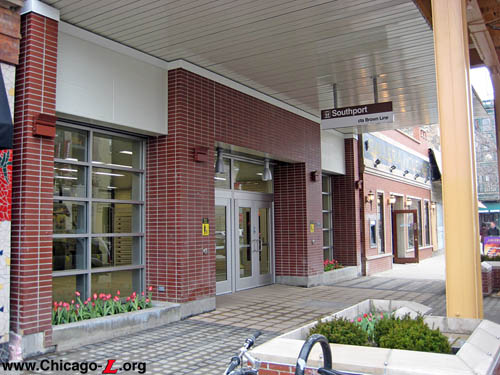
The new Southport station
house, with its brick exterior, large windows, and metal
copping, cornice, and panels, is seen looking southeast on
March 30, 2008. The drip pans over the sidewalk protect
customers from rain or snow falling through the open
elevated structure. Note the flower beds in front of the
station house. For a larger view, click here.
(Photo by Graham
Garfield)
|
Southport
(1400W/3400N)
Southport Avenue and
Roscoe Street, Lakeview
Service
Notes:

|
Brown Line:
Ravenswood
|

|
Accessible
Station
|
Quick Facts:
Address: 3411 N. Southport
Avenue
Established: May 18, 1907
Original Line: Northwestern Elevated Railroad, Ravenswood
branch
Previous Names: none
|
Skip-Stop Type:
|

|
Station
|
Rebuilt: 2007-08
Status: In Use
History:
Southport opened with the initial construction of the Ravenswood
branch of the Northwestern Elevated, which was placed into
service May 18, 1907. The station was designed in 1905-06 by the
Northwestern Elevated's Engineering Office and overseen by Chief
Engineer C.M. Mock and Consulting Engineer Charles Weston. The
station was built by the Angus Brothers construction company.
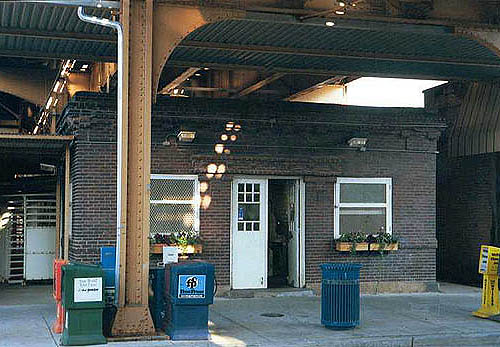
An exterior view of the
Southport station on the Ravenswood (Brown) Line, looking
east on September 10, 2000. The Southport station was well
intact architecturally until its renovation and was typical
of the 1906-07 Ravenswood branch elevated stations. Note the
plain brickwork and simple brick ornamentation around the
cornice and belt rail. (Photo by
Ernie Baudler)
|
The station house measured approximately 25 feet by 25 feet -- a
modest size and scale, relating to its role as a modest neighborhood
station -- and, when viewed in plan layout, was shaped like a
bow-tie. Passengers entered through the front doors and could exit
through the building as well, but ancillary exits were also available
along the sides of the building's exterior. The building narrowed in
the middle to provide space for an exit-only rotogate on each side of
the exterior, which passengers could exit through without entering
the building. The inclusion of such egress was a result of experience
with earlier stations, at which circulation could become congested
when passengers tried to enter and exit through the same confined
space simultaneously. In later years, the south rotogate was removed
and that side passage closed. The north rotogate and side passage
remained in use until the station was demolished and rebuilt.
The building's exterior was constructed of dark red brick and had
a fairly simple design. The foundation was built of stone and
concrete. The exterior walls were largely unadorned, except for
simple ornamentation around the cornice, belt rail, and in the hood
over the front entrance, all of which were executed in the same brick
as the rest of the exterior. The doors originally had multi-pane
windows.
The interior of the station was similarly modest. The interior
walls were clad in glazed brick and had paving brick flooring. A
large, bracketed, heavy wood beam ran across the width of the
interior in the center, relating a Craftsman influence to the simple
design. As built, there were two open areas on either side of the
doors at the front for circulation and concessions. The interior then
narrowed into the fare control array (due to the aforementioned
rotogates along the exterior), which originally consisted of an
agent's booth in the center flanked by turnstiles on one side and a
heating stove on the other. The original ticket agent's booth was
removed in the mid-1990s when the electronic farecard turnstiles were
installed, replaced by a new booth on the west wall.
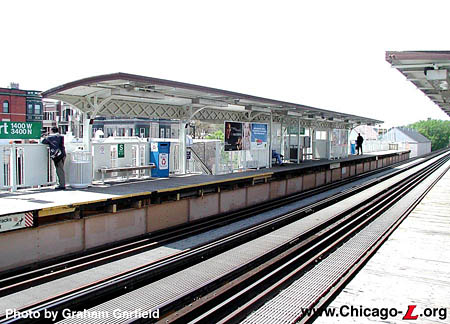
The Ravenswood branch
elevated stations had a uniform canopy design, including
those seen here looking west at Southport on May 13, 2002,
with a curved roof and elaborate latticework. For a larger
view, click here.
(Photo by Graham
Garfield)
|
After exiting through the station house's rear doors, passengers
walked down an enclosed passageway to access the stairs to the
platforms. The passageway featured full-height grillework consisting
of bars arranged in a geometric Craftsman pattern punctuated by
ornamental cast iron rosettes and an arched galvanized iron roof.
Originally, there was a full-height grille down the center of the
passageway, meaning passengers had to exit through a specific rear
door to access their desired platform, or they would have to reenter
the station house to switch to the other side. Most of the center
panels were later removed to allow access to either platform from the
passageway. The decorative grillework was carried up the stairways to
the platforms.
Southport featured dual side platforms, constructed of a wood deck
on a steel frame. The platforms featured canopies in the center,
covering the stairs from street-level. The canopies, which were
typical of the 1907 Ravenswood
branch stations, featured a gently arched roof with curved
support columns and latticed framing. The platform railings consisted
of cast iron posts supporting thin metal bars and ornamental
sunflower rosettes in a geometric design alternating with flat
panels, topped with an oak handrail. The canopy design would be
reused first on the Chicago & Oak Park Elevated (also owned by
Charles Yerkes) before becoming the standard for the "L" under the
Chicago Elevated Railroads and Chicago Rapid Transit. The railing
design was also reused elsewhere on the system, most notably at
Clinton/Lake where it was duplicated
almost exactly.
Southport became an "B" station under the skip-stop
express system instituted on August 1, 1949. The station reverted
to an all-stop when A/B
service was discontinued in 1995.
Southport station retained much of its original material until it
was renovated in 2007-08. In addition to the original station house
and canopies, a great deal of the original platform railings were
also intact. The platform extensions had simple, modern metal
railings. The platform also utilized bus shelters as windbreaks in
later years.
For decades, Southport served the working-class neighborhood it
surrounded, but this area saw a renaissance beginning in the 1990s,
with the small neighborhood shops and diners along Southport replaced
with higher-end cafes and coffee shops and specialized upscale
stores. Today, the station's usage has seen a marked increase with
renewed interest in this area.
Brown
Line Capacity Expansion Project
By 2004, ridership had exploded on the Brown
Line -- an 79% increase since 1979 and a 27% increase since 1998
-- such that during peak periods many trains were at crush-loaded,
resulting in commuters left standing on platforms unable to board the
loaded trains, sometimes waiting as one or two trains passed before
they were physically able to board. The problem in large part was
that all Brown Line stations could only accommodate six-car trains
(with the exception of Merchandise
Mart, Chicago, Fullerton
and Belmont, which could already hold
eight-car trains), which, along with the limitations of the cab
signal system, limited the line's capacity.
As a result, the CTA decided to plan for the Brown
Line Capacity Expansion Project, the largest capital improvement
project undertaken by the CTA at the time (surpassing even the Douglas
Renovation Project, which was the largest up to that point). The
main objectives of the Brown Line Capacity Expansion Project are to
expand the line's overall ridership capacity by lengthening station
platforms to accommodate eight rather than six-car trains,
rehabilitate rail infrastructure and stations, provide for station
enhancements to meet the accessibility requirements of the Americans
with Disabilities Act (ADA), and upgrade or replace traction power,
signal and communication equipment. By far, the largest part of the
Brown Line
Capacity Expansion Project was the station renovations. Of the
Brown Line's 19 stations, only one (Merchandise
Mart) was not touched at all due to its modern construction
(1988) and ability to berth eight-car trains.
On April 13, 2004, the CTA announced that it had officially received a Full Funding Grant
Agreement (FFGA) from the Federal Transit Administration (FTA).
However, in May 2004, CTA received construction bids for the project that substantially
exceeded the budget. As such, the Chicago Transit Board voted on June
9, 2004 to reorganize the project into several discrete pieces to
help attract more competitive construction bids. Station renovation
work was modified and grouped into five separate packages according
to location to help reduce the overall cost of station construction.
Southport station was grouped with Diversey,
Wellington, and Paulina
-- all of which were designed by the same consultant, Teng
-- in a bid package. Station designs were also revised to reduce
costs. Most changes concentrated on non-customer areas such as
reducing the size of janitor closets, employee restrooms, electrical
rooms and communication rooms. Other areas that were studied for cost
reduction were standardizing common station elements, the use of less
expensive materials, canopy designs and coverage, and temporary
station closures to provide contractors better access to the
sites.
The Paulina/Southport/Wellington/Diversey
contract was the fifth and last of the reorganized station packages
to be bid out. At the December 12, 2006 board meeting, a $66.9
million contract for the renovation of these stations was awarded to
FHP Tectonics
Corporation.
Station Design
The contract included construction of a new, modern station house,
extension of the platforms to accommodate 8-car trains, and
installation of elevators for ADA accessibility. The new expanded
station facility featured an increased number of turnstiles and
farecard vending machines.
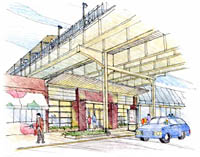
Artist's rendering of the
design for the renovated Southport station. A new masonry
station house with glass panels will replace the 1907
entrance. Brown Line-standard railings and lights are
visible at platform level above. For a larger view, click
here.
(Image provided courtesy of
the Chicago Transit Authority)
|
The new station house is located on the east side of Southport
Avenue, the same side as the old station house. The station house is
clad in glazed brick with metal coping along the top. The front of
the station house features vertical bands of aluminum-framed windows
topped aluminum wall panels on both sides of the central doors into
the station house. The front elevation is anchored by cast concrete
planters on both sides of the aluminum-framed storefront doors.
The station house has a long floorplan, elongated by the presence
of two sets of steel elevated structure columns connected in the
middle of the interior. The interior has a largely open plan with tan
modular glazed brick wall finishes. The farecard vending machines are
located just inside the station along the north wall, while the south
wall features a direct entrance to an adjacent retail store. The fare
controls are located at the first set of steel elevated columns, with
the turnstiles between the columns and exit rotogates on the outer
sides of the columns. The space between the columns creates a
corridor through the paid area, in the middle of which the Customer
Assistant booth is located. Artwork adorns the north and south walls
of the paid area on either side of the Customer Assistant booth.
The stairs to each platform are located at the rear of the paid
area, angled at 45-degrees to the station axis. The elevators to each
platform are located adjacent to each set of stairs, also angled. At
the first landing the stairways turn, ascending the rest of the way
to the platform parallel to the tracks and station house axis. The
stairways to the platforms are closed in a galvanized steel wire mesh
grille system.
The dual elevator towers, which dominate the massing of most of
the renovated Brown Line
stations, are set far back from the street at Southport, diminishing
their impact on the facility's appearance. The towers are clad in
aluminum wall panels. The portal from each elevator tower to their
respective platform is protected by a canopy projecting from the
tower, supported by a set of suspension cables.
The dual platforms were renovated with new decking, railings,
lighting, signage, and other fixtures. The existing original canopies
were retained and refurbished, stripped of decades of paint,
repainted dark brown, and topped with new corrugated metal arched
roofs. The new railings are a standard design for the rebuilt
Brown Line elevated
stations, with thick tubular top and bottom horizontal members with
rectangular panels with a grid pattern cut out. The railings and
light poles, as well as the other new metalwork, are hot-dipped
galvanized. The light poles are integrated into the railing posts.
The platforms are finished with windbreaks integrated into the
railing system with the glass panels protected by metal grilles
matching the railings. New benches with sandboxes integrated into
them dot the platform, posts with projecting horizontal arms for A/V
signs (to be installed later) are suspended over the platforms, and
Transit Information panels are to be posted at the tops of the
stairs.
Auxiliary exits are provided on the west side of Southport Avenue.
The auxiliary exit stairs are enclosed by the same decorative
white-painted metal grilles as the stairs from the station house. The
stairs from each platform descend into a common landing, then a
central set of stairs leads down to street-level with egress provided
by a pair of stainless steel exit rotogates.
Other improvements include new signage; new electrical,
communications, and HVAC equipment; customer heaters on the
platforms; security cameras; and a state-of-the-art announcement
system.
Station Renovation Work
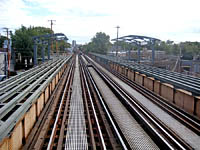
The decking having been
stripped and the original platform stringers refurbished,
new joists have been installed on September 16, 2007.
Several sections of the original canopies have been
temporarily removed. For a larger view, click
here.
(Photo by Graham
Garfield)
|
Construction at the Southport and Paulina
stations is expected to last approximately 13 months, with both
stations subject to temporary closure for 12 months during
construction. However, no two adjacent stations will be scheduled to
close at the same time on weekdays so customers may go to the next
closest station for service. During periods of temporary closure,
customers are encouraged to use the most convenient existing
CTA bus and rail service in
the area.
On Monday, April 2, 2007, Southport temporarily closed for
renovation. Southport will temporarily close for 12 months while
construction crews work to rebuild the station. The adjacent stations
-- Paulina and Belmont
-- will remain open during the temporary closure of the Southport
station so customers may continue to use them to access Brown
Line service.
The Southport station is located in an area where existing
CTA service is plentiful. In
addition to nearby rail stations, there are five existing
CTA bus routes that provide
service near Southport station on weekdays and weekends, the #9
Ashland, #22 Clark, #77 Belmont, #152 Addison and the #X9 Ashland
Express (weekday rush periods only).
During April and May 2007, crews worked to demolish the old
station house, as well as the platform decking and railings. The
wooden extensions at the ends of both platforms were also removed.
The canopies began being refurbished, with canvas enclosures
shrouding them as workers performed lead abatement.
By summer 2007, unneeded steel platform stringers were removed.
Several bays on the eastern ends of the canopies on both platforms
were also removed. New platform stringers were installed at the ends
of the platforms to extend them to 8-car length, as well as in the
middle of the platforms near the future site of the elevator towers.
During September, the steel framework of the elevator towers was
installed. During late summer and early autumn, the foundation for
the new station house was installed. During this period, crews also
worked to rehabilitate elevated structure's steel columns and renew
the column foundations, especially those that would later be
enveloped within the new station house.
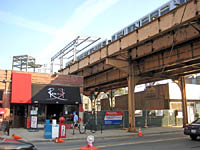
The former location of
Southport station, under reconstruction, is seen looking
southeast on October 7, 2007. Note that the canopies have
been striped down to the bare structure for refurbishment
and the station house has been removed. The outbound
elevator tower steel is visible behind the commercial
building on the left. For a larger view, click
here.
(Photo by Graham
Garfield)
|
With the elevator tower structures installed, the sections of the
platform canopy framework that were previously removed were
reinstalled in front of the towers during October 2007. The canopy
structures on both platforms were then detailed, primed, and painted.
Platform joists were installed during autumn.
Following the completion of foundation work during autumn,
structural steel for the new station house began to be erected in
late autumn. Work on the station house structure, including the
installation of utilities, systems, and basic cinderblock walls,
continued through autumn and into early winter.
During November, installation of the new wooden platform decking
began. Installation of the new decking would continue for several
months, into January 2008. During November, crews also primed the
refurbished platform canopy steel framework and painted it a dark
brown hue. White metal cladding began to be installed on the
framework of the elevator towers in late November, beginning with the
inbound platform tower. Installation of the exterior elevator panels
continued into January 2008.
Installation of galvanized steel railing and light poles on the
platforms, and well as the railing panels, began in December. Work on
the platform railings and light standards would continue for a couple
months.
Buildout of the station house continued in the new year.
Installation of cinderblock and masonry walls was performed in
January 2008 and work began on the station house's roof during the
same month. Installation of the elevator cabs and other system
components also began in January and would continue throughout
winter.
Work also continued on the platforms and platform canopies
throughout January and February 2008. Light fixtures and speakers
began to be installed on the light poles during this period. The
stairs from the back of the station house to both island platforms
were installed during January, while the auxiliary exit stairs from
the platforms to the west side of Southport Avenue were installed
during February.
Southport station reopened at 5am, Sunday, March 30, 2008. With
the new elevators in operation on opening day, Southport became the
81st of the CTA's 144 station
to become accessible, with other ADA-compliant features including an
accessible turnstile, tactile platform edging, gap fillers, TTY
telephones and Braille signs.
At the same time Southport reopened, the Paulina
station closed for renovations for up to one year. Modest work
continued at Southport station after the reopening, as the contractor
completed various punchlist work.
On April 11, 2008, Mayor Richard M. Daley, CTA Chairman Carole Brown, CTA President Ron Huberman and other CTA official,s and community today officially dedicated the renovated Southport Brown Line station.
To foster a sense of ownership and identity within each station and the surrounding community, the CTA partnered with the City of Chicago's Department of Cultural Affairs to install public art at all 18 stations included in the Brown Line Capacity Expansion project. For Southport, Chicago-based artist Elizabeth Fraiberg created two ceramic tile murals that are located inside the stationhouse and depict layered, abstract photographs of the surrounding neighborhood.
At the dedication ceremony, Daley, Brown, and Huberman also previewed a new digital advertising and communications initiative that was planned to enable the CTA to provide next train arrival information and notify customers of service changes and was also expected to provide the CTA with more than $100 million in revenue. The day before the dedication, the Chicago Transit Board authorized a 10-year contract with Titan Outdoor to allow them to sell digital advertising on the large digital screens.
The Brown Line
Capacity Expansion Project Full Funding Grant Agreement with the
federal government requires that the
CTA complete the entire
project by the end of 2009.
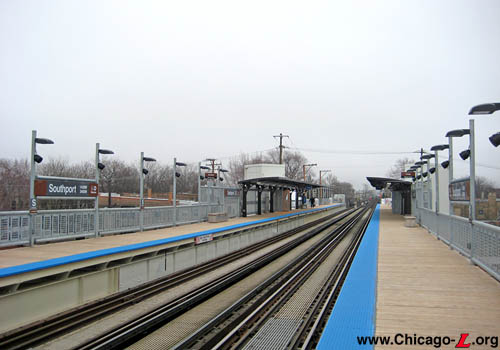
Southport station's
renovated dual side platforms, with their Brown
Line-standard galvanized steel railings, masonry and
metal-clad elevator towers, and refurbished 1907-vintage
canopies, are seen looking east on March 30, 2008. For a
larger view, click here.
(Photo by Graham
Garfield)
|
 Old Southport
(1907-2007) |
New Southport
(2007-present)
Old Southport
(1907-2007) |
New Southport
(2007-present)
Old Southport station
(1907-2007)
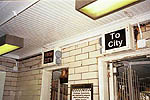
|
southport02.jpg
(82k)
A view of the interior of the Southport station, with a deal
of the area over the back doorway. The "To City" and "From
City" signs are original and alert passengers to approaching
trains by lighting up and sounding a bell. The backlit plate
on the left is original (or at least much older) while the
sign on the right is newer: note the difference in lettering
typefaces. Note also the glazed brick walls and
tongue-in-groove paneled ceiling. (Photo by
Ernie Baudler)
|
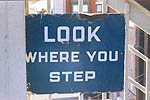
|
southportSign2.jpg
(61k)
Southport, along with several other Ravenswood branch
stations, have several old, original blue and white enamel
signs still in place. This "Watch Your Step" sign is at knee
level at the top of the stairway at platform level.
(Photo by Ernie Baudler)
|

|
southport03.jpg
(69k)
Cars 6129-6130, leading this train, were built with
experimental equipment, with a "high performance mode." In
1960, they received a distinctive maroon and gray paint
scheme. They're stopped at Southport on September 6,
1962. (Photo by Roy G. Benedict)
|
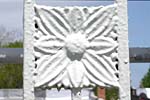
|
southport05.jpg
(127k)
The elevated stations on the Ravenswood branch have a
sunflower cast into the decorative platform and stair
railings, like the one seen here at Southport on May 13,
2002. (Photo by Graham Garfield)
|
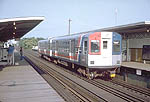
|
cta6015.jpg
(111k)
Decked out in its Bicentennial spender as "Anthony Wayne",
6015-6016 stops at Southport station on a Ravenswood
All-Stop run on July 7, 1975. (Photo by Doug
Grotjahn, Collection of Joe Testagrose)
|
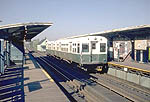
|
cta6023b.jpg
(117k)
CTA 6023 picks up the rear of a 2-car Ravenswood All-Stop at
Southport on October 2, 1972.
(Photo by Steve Zabel, Collection of
Joe Testagrose)
|
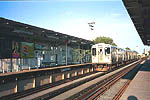
|
cta3437a.jpg
(74k)
A northbound Brown Line train of 3200-series
cars heading for Kimball, led by
car 3437, stops at Southport on September 10, 2000.
(Photo by Ernie Baudler)
|
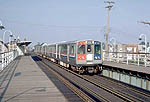
|
cta2434.jpg
(107k)
A six-car Ravenswood All-Stop is trailed by car 2434,
stopping at Southport sometime probably in the late 1970s.
Note the old-style A/B symbol sign on one of the "shepherd's
crook" platform lights; this at least dates the scene to
before the implementation of the KDR
color-coded signage. (Collection of Joe
Testagrose)
|
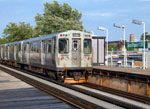 |
cta3326.jpg (253k)
Car 3326 beings up the rear of a Loop-bound Brown Line train departing Southport station on July 1, 2006. Work to rebuild the station began about a year later. (Photo by Dennis Herbuth) |
New Southport
station
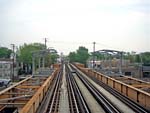
|
southport07.jpg
(167k)
The Southport platforms are seen looking east on May 23,
2007. The decking has been removed, allowing the steel
stringers to be refurbished. Some sections of steel platform
supports have also been removed for replacement. Flagmen in
the distance protect the contractors from passing
trains. (Photo by
Graham Garfield)
|
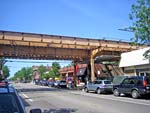
|
southport08.jpg
(179k)
The canopies at Southport have been completely stripped and
the platform decking and railings removed in this May 27,
2007 view looking north, with only the original platform
steel remaining. (Photo by Graham
Garfield)
|
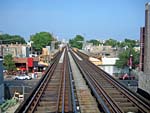
|
southport09.jpg
(189k)
The platforms and canopies at Southport have been completely
stripped down in this June 24, 2007 view looking east,
leaving only the original platform steel after the various
platform extensions of past decades have been removed.
(Photo by Graham Garfield)
|
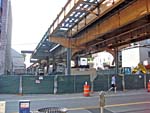
|
southport11.jpg
(176k)
The original steel elevated structure columns and columns
bases at Southport are being refurbished and new steel
installed to extend the length of the inbound platforms in
this October 7, 2007 view looking west. Steel has been set
for the top landing for the new auxiliary exit stair from
the inbound platform to the west side of Southport
Avenue. (Photo by
Graham Garfield)
|
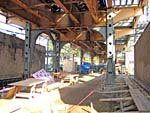
|
southport12.jpg
(203k)
Work is underway on the foundation for the new station house
in this October 7, 2007 view looking east. The existing
columns, cross-braces, and bases have been refurbished and
will be enclosed within the new station house when it is
built. New foundations for the headhouse are being
excavated, with some rebar already instal.
(Photo by Graham Garfield)
|
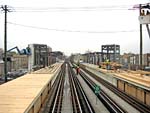
|
southport14.jpg
(174k)
One contractor works on the new platform decking on the
northbound platform at Southport, protected by a flagman on
the tracks, while another contractor works from the safety
of a cherry picker to install the metal panels on the
exterior of the southbound elevator in this November 26,
2007 view looking west. (Photo by Graham
Garfield)
|
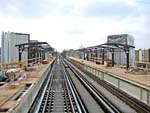
|
southport15.jpg
(166k)
The entire canopy structure, including the latticework on
the back, has been refurbished, reassembled and repainted
dark brown. Meanwhile, work on the elevator towers is
proceeding, with the white metal cladding nearly complete on
the southbound tower, seen looking west at Southport on
December 30, 2007. (Photo by Graham
Garfield)
|
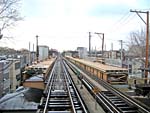
|
southport16.jpg
(189k)
Renovation of the Southport station platforms is progressing
in this view looking west on December 30, 2007, with the
installation of the galvanized steel railings and light
poles and wood platform decking proceeding along the entire
length of both platforms. (Photo by Graham
Garfield)
|
|

|

|


























